Ear infections in dogs and cats
EAR INFECTIONS IN DOGS AND CATS – part 1 – causes of ear infections
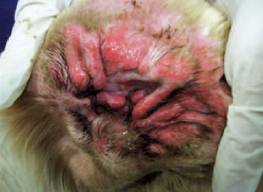
[ad name=”Tweet”]
A recurring ear infection in your pet is one of the more expensive and most frustrating animal diseases for pet owners to deal with. There are many causes of ear infections in dogs and cats, from simple ear mites to food allergies and cancerous growths down the ear canal. Some are easily fixed, but others require months to years of treatment and sadly, some are never fully controlled and eventually lead to permanent ear damage and loss of hearing.
THE ANATOMY OF THE EAR
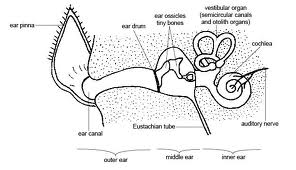
The fleshy part of the ear we all see is only half of the full extent of the ear. The fleshy part is called the pinna and is a layer of skin over cartilage, and in the middle going down into the skull is the ear canal. The ear canal has two parts – a vertical part we all see and then at right angles to the, a horizontal part which leads directly to the eardrum. The abrupt change in direction of the ear canal helps prevent injury to the eardrum so that, a long stick, for example that pokes down the ear will seldom hit the eardrum but it also means that smaller objects like grass awns can easily get lodged down there.
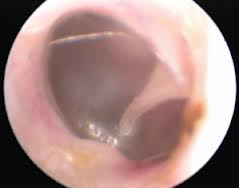
The eardrum lies between the ear canal and the middle ear which contains three bones which conduct sound into the skull. Inside the skull behind the middle ear lies the inner ear which contains areas for hearing and balance, the semi circular canals and the cochlea. Fluid inside the middle ear for example in an ear infection, often makes an animal very deaf as the bones cannot conduct sounds properly. Inflammation or infection in the inner ear can cause loss of balance and hearing as well. The 8th cranial nerve feeds directly into the brain from the inner ear and conducts information on hearing and balance. Animals with inner ear infections often feel nauseous, dizzy, have no balance and their eyes may flick from side to side. (nystagmus)
SYMPTOMS OF EAR INFECTIONS IN CATS AND DOGS
- Shaking of the head
- Scratching of the ear
- Ear look red and inflamed down the ear canal
- There is a sour smell coming from the ears
- There is a liquid noise when the ears are massaged or the dog shakes it’s head
- Yellow pus or greasy brown black dirt that keeps on having to be cleaned out the ears by the owner.
- The animal either adores the ears being rubbed, or cries in pain when anyone goes near them or touches them.
- The skin of the ear canal can over time become very thickened and greyish in colour, with a cobblestone appearance.
- The skin of the ear canal in acute ear infections is bright red, often moist and painful.
- With middle ear infections animals can be nauseous, off balance and the eyes can flick from side to side.
- The animals rub or scratch the skin below or nears the ears and can sometimes cause so much damage that a hotspot can form. (acute moist eczema)
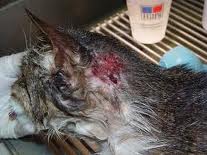
Hotspots by the ear are often a result of scratching from an ear infection
CAUSES OF EAR INFECTIONS IN DOGS AND CATS
ALLERGIES
By far the most common cause of ear infections in dogs and cats, especially ear infections that keep on recurring is ALLERGIC SKIN DISEASE.
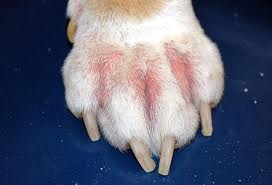
Animals that have red or itchy skins can also get red itchy ears, and red itchy ears tend to become moist inside because of the inflammation. Animals with dermatitis or skin allergies often have a genetically poor skin barrier. (layer on the skin’s surface that tends to keep bacteria out) A warm, moist environment, coupled with a poor skin barrier allows bacteria and yeasts to thrive and multiply, causing an ear infection. Allergic ear disease typically gets better when eardrops or steroids (cortisone) are used, then flares up again soon after the medication finishes. Animals with allergic ears often do well on a hypoallergenic diet as food allergies often show up as ear infections.
EAR MITES
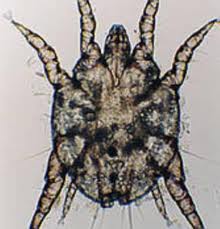
(Otodectes cynotis) are commonly seen in young kittens and puppies that have come from places with poor hygiene and or multiple pet households. These animals typically shake the head and scratch the ears a lot and the dirt in the ear canal can vary from thick flakes to brown and crumbly. Mites can be very contagious but luckily are easily treated. Your vet may prescribe ear drops to soothe the ears but also a drop that gets put on the back of the neck that will last a month and will kill the ear mites. (Revolution, Stronghold, Advocate) You may need to use the drop monthly up to 3 times to get of stubborn ear mites. If you suspect your pet has ear mites you should have a vet check the scaly dry discharge in the ears under the microscope to confirm this.
FOREIGN BODIES IN THE EAR

The most common things that get lodged down the ears canal are small things like GRASS AWNS. These awns have tiny spikes on them that stick to the skin inside the ear canal so that the pet cannot dislodge them by shaking the head. If your vet suspects a grass awn, he/she will have to sedate your pet, examine the ear canal and remove it.
BACTERIAL EAR INFECTIONS
Ears that have a bacterial infection in them are smelly and often filled with yellow or brown pus. They can be very painful and inflammed as well. Most BACTERIAL EAR INFECTIONS are not primary infections but are secondary to some other cause, for example allergies or trauma from a foreign body lodged down the ear. In rare cases a resistant bacteria can be the cause of an ear infection. If your vet suspects a primary or resistant bacterial ear infection, he/she will take a swab from the ear canal and send it to the lab for culture to check which antibiotic is the best one to use to treat the infection and for how long.
YEAST EAR INFECTIONS
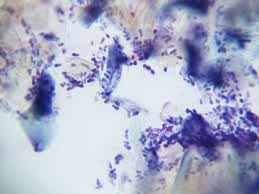
Yeasts (Malassiezia most commonly) like to grow where it is warm and humid, so an inflamed ear is ideal for them to thrive in. Yeast infections can be very itchy and animals shake their heads a lot. the ears often stink and have a sour, fishy smell.There is often a lot of discharge in the ear which can vary from greasy brown to pussy. As with bacterial infections, yeast infections tend to be secondary to other causes.
PHYSICAL OBSTRUCTIONS IN THE EAR CANAL
- Scarring and thickening of the ear canal from constant infections makes it hard for the body to fight infections as the pus and discharge becomes trapped inside a very narrow ear canal.
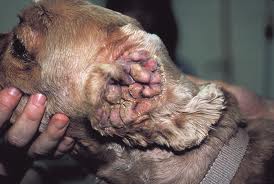
The skin is so thick here you cannot even find the opening to the ear canal - Growths, polyps or extreme enlargement of the wax producing glands (ceruminous gland hyperplasia) inside the ear canal block the normal cleaning mechanisms of the ear so dirt gets trapped inside which can get infected
- Damage to the ear at all from a previous injury can block the drainage of the ear
ANAL GLAND TROUBLE
Some dogs with anal gland issues are prone to getting ear infections
see our next article: TREATING EAR INFECTIONS IN DOGS AND CATS

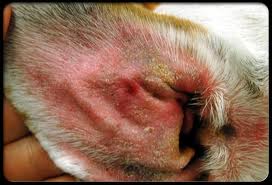
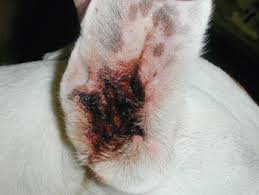
Leave a Reply
You must be logged in to post a comment.